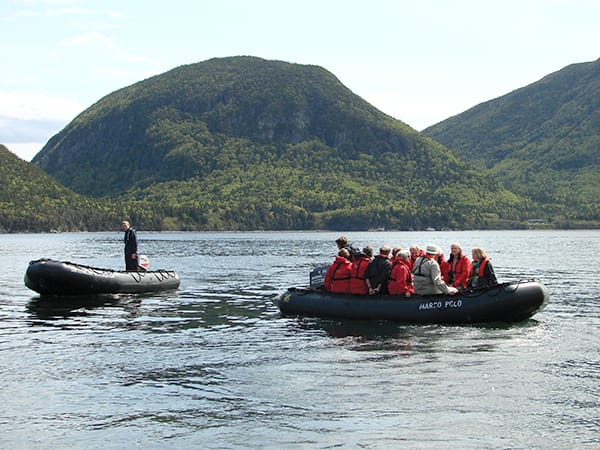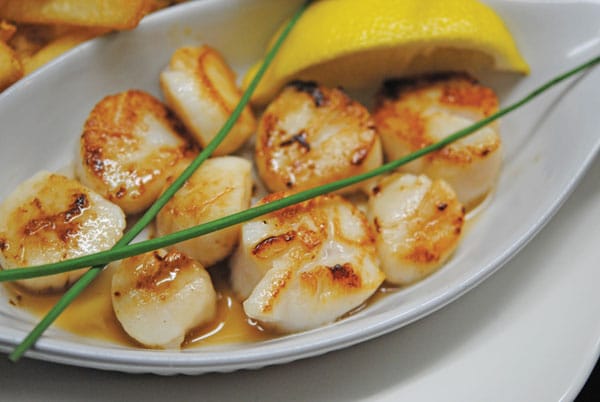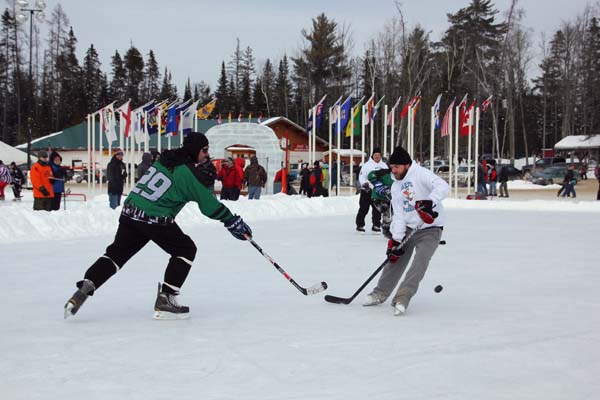Exploring Newfoundland by boat—the German way
When the announcement finally came, it was, as usual, in two languages:
“Eisberg auf der bord seite!” “Iceberg on the port side!”
We were approaching Iceberg Alley, the area of the Atlantic Ocean off northern Newfoundland where the frigid Labrador Current eases south, bringing with it huge sculpted chunks of glacier ice from Greenland.
Sure enough, everyone came on deck to view a giant craggy mountain of ice, streaked with blue, about the size of a small apartment building. It was floating lazily above a calm, grey sea.
These awesome floaters are common, even in summer months, along the east coast of Newfoundland and Labrador. It’s one of the reasons that small-ship cruising is becoming more popular in Atlantic Canada and Arctic waters.

Our expedition ship was the MS Hanseatic, a 180-passenger vessel designed for luxury cruising in hard-to-reach places on all seven continents. Operated by the Hamburg-based Hapag-Lloyd Cruises, Hanseatic normally caters exclusively to German-speaking guests but has added several bilingual (German-English) cruises each year.
Most of the Canadians and Americans on board were veteran cruisers who wanted the opportunity to see a spectacular province in a different way. The itinerary was ideal. It started and ended in Halifax with stops in Quebec City, several large and small ports in Newfoundland and Labrador, the thousand-year-old Norse settlement at L’Anse aux Meadows, plus a touch of France in St. Pierre et Miquelon. As D’Arcy Sheedy confesses to us, “I’m a downtown Toronto person, so Newfoundland is a complete other world to me. I know it’s been referred to as ‘The Rock.’ I now know why.”

Unlike the big cruise ships, Hanseatic can let passengers see that rock up close. At our first Newfoundland stop near Gros Morne National Park with its ancient cliffs, lofty flat-topped mountains and deep fjords, the Hanseatic lowered its 14 zodiacs (each named for a famous explorer) and took guests along the coastline and into the small outport of Lark Harbour (it was the first-ever cruise ship visit to that community). The zodiacs—one of which was piloted by the captain himself: “I love it. I can get some fresh air and, unlike the Hanseatic, I can go full ahead”—then took us on a surprise expedition around a rocky bluff to an awaiting Cape Island boat. There, to everyone’s delight, the ship’s hotel manager, Doris Adler, accompanied by two local fishermen, poured flutes of iced champagne and passed them over to the zodiacs. A ‘toast at sea’ took on a whole new meaning, not just for us but for the elated fishermen whose boat was hired for the afternoon. “We’ve had a few beers before,” quips lobsterman Victor Sheppard with a grin. “But it’s the first time we’ve had champagne.”
From zodiacs to two formal dinners and several receptions, there were plenty of opportunities for Hanseatic guests to enjoy champagne, plus lobster, caviar, snow crab and the many other gourmet delicacies that define a five-star cruise ship. Even the buffet breakfasts and lunches included a variety of offerings as good, or better, than on the large ships. Evening meals were a leisurely affair with five or six courses, constant changing of the silverware, glasses and Rosenthal china, depending on the guests’ choices. An alternative 30-seat restaurant on the top deck offered, at no extra cost, theme evenings— Newfoundland, American, French, Asian—with half a dozen small sampler dishes and a couple of larger entrées. The chef was extremely imaginative in her presentations. The level of service from the German waiters (all of whom spoke excellent English) showed evidence of impeccable training.
The daily afternoon tea was also a delight with extravagant pastries and no fewer that 22 tea choices (more than Cunard offers on the Queen Mary).
Germans tend to be formal and even though most evenings were billed as “casual,” the majority of male guests dressed up with shirts, ties and dinner jackets. When there was evening entertainment (most nights a leisurely dinner and piano bar sufficed), it was a clarinet and piano duo interspersed with poetry readings.
Hapag-Lloyd is known for its onboard naturalists and we had three on this cruise, all with advanced degrees and a thorough knowledge of Newfoundland and Labrador and its unique history, geology, flora and fauna. Pre-dinner lectures gave us a good idea of what to expect the next day. Willson McTavish of Mississauga, Ontario, was impressed that the German guides gave so much time to the minority English-speaking travellers, not only before landings but during the many tours we enjoyed. “Every day we were encouraged to do something. I liked that,” he says. “Forces you out of bed. Go out on the water. Go climb a hill. Go see something together. That’s nice.”
Elaine Lund of Ottawa and her husband, Ken, had toured Newfoundland by car before but never by sea. “It’s really two different worlds,” she says. “Totally different approaching town from the water. But the Newfoundlanders are the same everywhere. Hospitable to their core.”
Willson McTavish loves Newfoundlanders “for the way they speak. They do have an accent and you have to have an ear for it. Once you get it, it’s wonderful.”
D’Arcy Sheedy and his wife chose the cruise spontaneously. “We did little research so every port was a pleasant surprise,” he says. “I really think more Canadians should do something like this. But there’s a terrible problem in our country. It often costs less to fly to England than to Halifax. And that’s not right.”
If you go: hl-cruises.com



